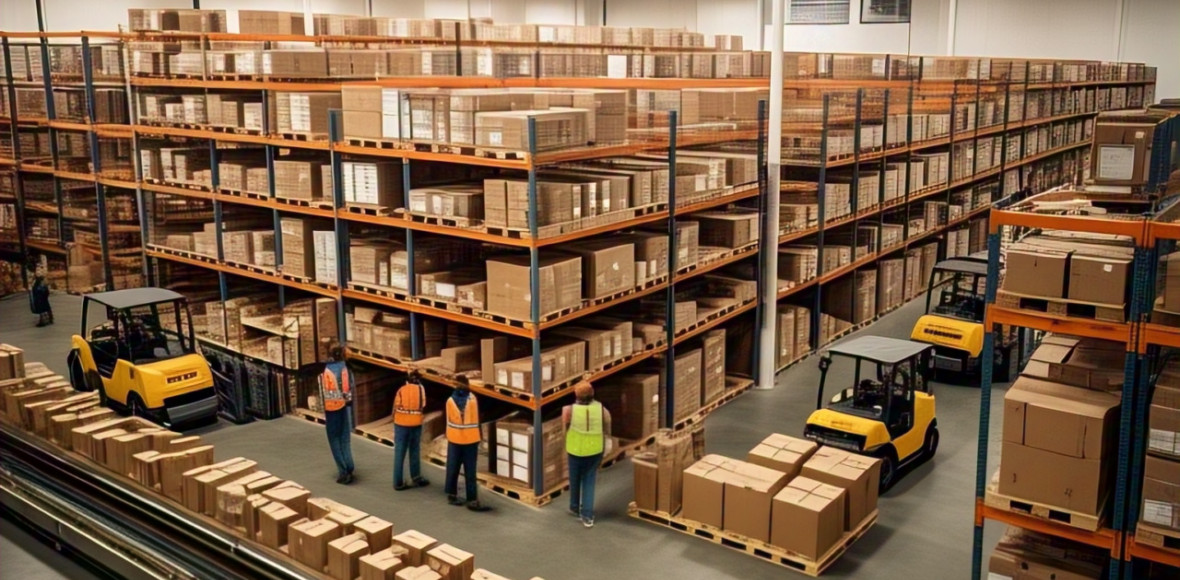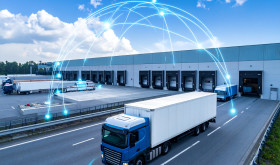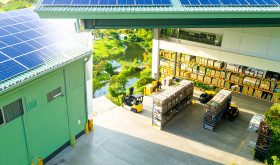
In 2025, warehouse management is undergoing a major evolution. The traditional warehouse management systems that just tracked stock, guided picking and packing, and handled put-away are being replaced by intelligent, connected, and sustainable systems. These new warehouse management system platforms are becoming key to how companies deal with worker shortages, higher costs, online shopping demands, green goals, and the need for flexible supply chains.
Here’s how and why this shift is happening in three main areas: AI & automation, flexibility & changes in fulfilment methods, and sustainability & resilience.
- AI & automation: The brain of the smart warehouse
Today’s warehouse management systems have evolved beyond basic rule engines. They now have an impact on analytics, adaptability, and proactivity. Here are the main changes:
- AI modules use real-time data from IoT sensors, mobile devices, and connected equipment to predict demand, fine-tune inventory, and assign workers and machines as needed. This data flows in nonstop.
- Automation of handling and movement: Warehouses now run smoother with automated systems working hand-in-hand with warehouse management system. These include automated storage & retrieval systems (AS/RS), autonomous mobile robots (AMRs), and collaborative robots (cobots). Together, they make storage more compact, speed up item picking, cut down travel time, and reduce mistakes.
- Software orchestration: Warehouse management system isn’t just a module—it’s becoming the control centre for intralogistics, making decisions about robot movements, human picker interactions, and zone replenishment. The focus is on software-controlled automation, not just hardware.
The upside: companies can handle changing demand better, cut down on wasted travel time and worker downtime, and turn warehouses from cost centres into adaptive fulfilment hubs. One report states the warehouse management system sector is set to expand by about 19.5% each year until 2030.
Remember, the push for AI and automation isn’t just about swapping out workers: the warehouse management system needs to blend human-machine teamwork (like humans making complex decisions and robots doing repetitive jobs), and the setup should be easy to grow, change, and update.
- Agility & fulfilment model changes: Adapting to the new logistics scene
The logistics scene is more unpredictable than ever: changing consumer habits, micro-fulfilment needs, workforce constraints, and worldwide disruptions. Warehouse management system platforms are adjusting in several ways:
- Micro-fulfilment centres: Warehouses are fragmenting. We now see local small warehouses near end customers (in cities) alongside huge central distribution centres. This change aims to meet the need for speed. Modern warehouse management systems support these micro-hubs, making operations in smaller spaces more productive and faster.
- Flexible stock-holding strategies: Companies are reconsidering whether to centralize or spread out their stock. A smart warehouse management system lets you see stock across locations, refill in real-time, and shift stock between channels (online sales, wholesale, and retail) as needed. For 2025, this is a strategic choice rather than just an operational detail.
- Brownfield upgrades: Many warehouses aren’t new builds—they’re existing setups with limited space. Smart warehouse management systems support refits, step-by-step improvements (starting with software), and add-on automation. This means warehouses can update without needing a complete overhaul.
These trends show that a modern warehouse management system needs to be flexible: it should support multi-node networks, omni-channel fulfilment, dynamic labour and resource management, and quick changes in workflows. The warehouse management system turns into the backbone of responsiveness instead of just providing stability.
- Sustainability & resilience: A key business priority
In 2025, sustainability is no longer optional—it will be an integrated part of warehouse operations. Companies will expect warehouse management system platforms to play a crucial role in making warehousing greener and measuring its impact:
- Energy-efficiency optimisation: Warehouse management systems look at data on lighting, temperature, equipment usage, and scheduling. This helps cut down on idle time, optimise traversal paths, and thereby reduce energy consumption.
- Material-waste reduction: The system helps use less by getting packaging just right, picking items, and moving inventory faster. This means less stock goes to waste, fewer mistakes in picking, and less unnecessary moving around—all of which save money and are better for the environment.
- Risk management & resilience: Today’s warehouse management system has features for planning different scenarios, modelling disruptions, creating digital twins, and predicting maintenance needs. These tools help warehouses respond to supply chain problems and keep service at expected levels.
Looking at it from a business angle, making warehouses more sustainable aligns with broader ESG goals, follows the rules (in places like Singapore and Southeast Asia), and meets what customers want in terms of being open and eco-friendly.
- Implications for SMEs and regional players (e.g., Singapore/Southeast Asia)
These shifts create both chances and hurdles for many small and medium-sized businesses and local logistics providers in Southeast Asia, Singapore included:
- Opportunity: As e-commerce keeps growing faster, these companies can skip old systems and start using cloud-based smart WMS solutions without spending too much upfront. Even mid-sized companies can now use modern WMS because micro-fulfilment centres are flexible, and they can rent automation services instead of buying them outright.
- Challenge: The cost, complexity, and skills gap continue to pose big problems. Putting automation or an advanced warehouse management system into action needs change management linking with current systems (ERP OMS) and teaching staff to work with robot/AI-enabled workflows. For SMEs, it can take longer (several years) to see returns on their investment, and they often have less money to spend.
- Recommendation: Regional players should adopt a step-by-step approach. They should begin with warehouse management system layers to boost visibility and make better use of workers and assets. Over time, they can add automation or AI components. It makes sense to pick a warehouse management system that works with both manual and robotic processes and can be set up in the cloud. It’s also smarter to line up WMS investments with green goals, which local rule-makers often push for in Singapore and Southeast Asia.
- Practical steps for organisations implementing a smart WMS
Here are five key points for companies to consider when they plan to adopt or upgrade a WMS to the “smart” level:
- Define clear objectives: What do you want the warehouse management system to accomplish? Do you aim to cut labour costs, boost output, improve precision, shrink your footprint, or make operations more eco-friendly? Make sure the warehouse management system features (like AI analysis, robot integration, and small-hub support) line up with these aims.
- Assess current state and roadmap: Many warehouses are “brownfield,” meaning they have existing equipment, processes, and limits. Figure out where you stand now (in terms of stock accuracy, travel time, and how long it takes to fulfil orders) and create a step-by-step plan instead of trying to change everything at once.
- Choose a modular, open-architecture warehouse management system: A cutting-edge warehouse management system should work with mobile devices, IoT sensors, robots, and cloud analytics. Stay away from closed systems that tie you to one company or stop you from upgrading later.
- Focus on data & visibility: A smart warehouse management system is only as good as the data it receives. Invest in IoT sensors, barcodes/RFID, location tracking, and mobile interfaces. Use dashboards to monitor key metrics: order-cycle time, picking error rate, labour productivity, and energy consumption.
- Plan for change management & training: As robots help pickers and workflows reorder dynamically, employees will need to learn new skills. Companies must update job designs and safety rules. Remember to budget for maintenance and support of automated equipment.
- Outlook: What to keep an eye on for 2025-2030
- Automation-as-a-service (AaaS) models are becoming more common. Companies now pay to use robotics or warehouse management system modules as needed, which cuts down on upfront costs.
- Warehouse management systems now use digital twin models more often. These models run simulations of workers, robots, and stock to improve operations before making real changes.
- Micro-fulfilment centres are popping up more in city logistics networks. This means warehouse management systems need to handle many small sites instead of one big warehouse.
- Stricter rules and customer demand for greener supply chains: Warehouse management systems will now have features to track carbon output, power use , waste reduction, and audit trails.
- Expansion of AI control throughout the whole in-house logistics setup: from mapping routes for autonomous mobile robots to changing zones on the fly, warehouse management systems will run the warehouse’s “robot helpers” as much as its human staff.
Conclusion
In 2025, a warehouse management system will be more than just software that tracks items in a warehouse. It will serve as the control centre of a complex, ever-changing, multi-node fulfilment ecosystem—driven by AI, robotics, up-to-the-minute data, and the need to be sustainable.
For companies in fast-paced markets like Singapore and Southeast Asia, the key lies in adopting a smart warehouse management system strategy: one that prioritises visibility, flexibility, modular automation, eco-friendly operation, and teamwork between humans and machines. Beginning with reliable data, adaptable architecture, and well-defined goals will help navigate the cost curve and seize the significant benefits of this transformation.










